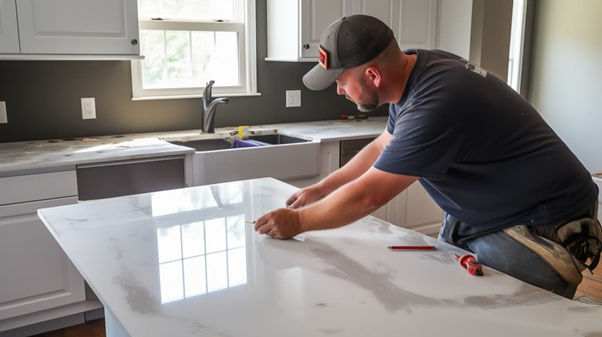
Enhancing Your Kitchen: A Comprehensive Guide to Quartz Countertop Installation
In today’s home design landscape, kitchen countertops play a pivotal role in both aesthetics and functionality. Among the myriad options available, quartz countertops have emerged as a top choice for homeowners seeking a blend of elegance, durability, and low maintenance. This comprehensive guide provides an in-depth look at quartz countertop installation, ensuring you make an informed decision to enhance your kitchen.
Understanding Quartz Countertops
Quartz countertops are engineered surfaces made from a blend of natural quartz crystals and resins. This mixture creates a robust material that mimics the appearance of natural stone while offering superior durability. Unlike natural stones, quartz countertops are non-porous, which means they resist staining and require less upkeep. Their uniform appearance and wide range of colors and patterns make them a versatile choice for modern kitchens.
Benefits of Quartz Countertops
- Durability: Quartz countertops are highly resistant to scratches, chips, and cracks. This durability makes them ideal for high-traffic areas like kitchens where wear and tear are common.
- Non-Porous Surface: The non-porous nature of quartz prevents the absorption of liquids, reducing the risk of bacterial growth and staining. This feature simplifies cleaning and maintenance.
- Aesthetic Variety: Available in numerous colors and patterns, quartz countertops can replicate the look of natural stone, such as granite or marble, while offering consistent patterns and colors.
- Low Maintenance: Unlike natural stone countertops that require periodic sealing, quartz countertops do not need special treatments. A simple soap-and-water solution is usually sufficient for cleaning.
Preparing for Quartz Countertop Installation
Before embarking on quartz countertop installation, proper preparation is crucial to ensure a smooth process. Here are the essential steps:
- Measure Your Space: Accurate measurements are vital for ensuring that your quartz countertops fit perfectly. Consider hiring a professional to take precise measurements of your kitchen layout.
- Choose Your Quartz: Select a quartz pattern and color that complements your kitchen design. Samples and swatches can help visualize how different options will look in your space.
- Prepare the Substrate: The surface where the quartz countertop will be installed must be level and structurally sound. Any necessary repairs or adjustments should be made before installation begins.
- Remove Existing Countertops: If you have existing countertops, they will need to be removed carefully to avoid damage to the underlying cabinets and walls.
The Installation Process
- Template Creation: A template of your kitchen layout will be created to ensure that the quartz countertop fits accurately. This template is often made using digital measurements or physical templates.
- Fabrication: Based on the template, the quartz slabs are cut and shaped to fit your kitchen layout. This step involves precise cutting and edge finishing to ensure a perfect fit.
- Installation: The fabricated quartz slabs are then transported to your home and installed. Installation typically involves securing the countertops to the base cabinets, aligning seams, and ensuring a level surface.
- Sealing and Finishing: While quartz countertops are non-porous and do not require sealing, any joints or seams may be treated to ensure a seamless appearance. The final step includes cleaning the surface and inspecting for any imperfections.
Post-Installation Care and Maintenance
After your quartz countertops are installed, maintaining their pristine condition is straightforward:
- Daily Cleaning: Use a mild dish soap and water solution to clean the surface. Avoid abrasive cleaners or scouring pads that can damage the finish.
- Preventing Stains: While quartz is stain-resistant, it’s advisable to wipe up spills promptly to avoid any potential staining from strong chemicals or food items.
- Avoiding Heat Damage: Although quartz countertops are heat resistant, it’s best to use trivets or heat pads for hot pots and pans to prevent any potential damage.
- Routine Inspections: Regularly check for any signs of damage or wear. Address any issues promptly to maintain the countertop’s longevity.
Conclusion
Quartz countertop installation can significantly enhance the functionality and visual appeal of your kitchen. By understanding the benefits, preparing adequately, and following the correct installation process, you can ensure that your new quartz countertops will provide lasting beauty and durability. With minimal maintenance required, quartz countertops offer a practical yet stylish solution for today’s modern kitchens, making them a worthwhile investment for any homeowner seeking to elevate their culinary space.



